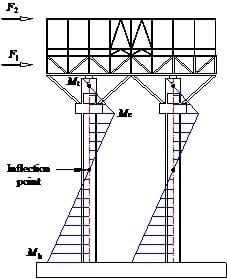3.2.3. Deterioration Behavior
Strength and stiffness deterioration has fatal influence on the seismic capacity and collapse behavior of structural systems [
19]. The secant stiffness
Ki used to indicate the overall stiffness of the specimen is calculated by the following formula [
20]:
where +
Fi and −
Fi are respectively the peak load under the
i-th loading case of the PDTs in two opposite directions; +
Xi and −
Xi are respectively the displacement corresponding to the peak load under the
i-th loading case of the PDTs in two opposite directions.
In order to evaluate the stiffness deterioration of the specimen with the increase of PGA, the relative stiffness ratio
kre is defined as:
where
Ki is the secant stiffness of the specimen under each loading case of the PDTs calculated by Equation (6);
K1 is the secant stiffness of the specimen under the first loading case when PGA equaled to 0.05 g. Specially, when PGA is 0.05 g, the relative stiffness ratio
kre is 100%.
Figure 12a shows the stiffness and relative stiffness ratio of the specimen under different loading cases of the PDTs. It can be found that the specimen had obvious stiffness deterioration characteristics, occurring mainly within the PGA of 0.20 g. It resulted from the macro-cracks occurring and propagation on RC pipe columns. The experimental phenomenon indicated that when the PGA was equal to 0.20 g, the cracks firstly occurred on the bottom of RC pipe columns, and then with the increase of loading steps, cracks occurred on the lower part of the corbel of column. Compared with the specimen under the PGA of 0.05 g, the stiffness decreased about 32.8% when PGA equaled to 0.20 g. When PGA was greater than 0.20 g, the speed of stiffness deterioration then slowed. It was probably accounted for the crack propagation of the specimen. When the PGA came up 0.40 g which referred to the major earthquake having 2% probability in 50 years, the stiffness was about 60% of the initial stiffness. After PGA equaled to 0.80 g, the stiffness was about 41% of the initial stiffness. This indicated that this structure had a rather good stiffness performance.
In addition, test results showed that steel diagonal braces nearly kept elastic during the loading process, correspondingly, the buckling of steel rebar, concrete crushing and slip are the key factors related to the stiffness deterioration for this kind of steel-concrete hybrid structure. This phenomenon coincided with the design expect, that is, most of earthquake energy would be dissipated by the columns while the steel diagonal braces should not failure or sustain severe damage ahead of the column. Because the steel diagonal braces are the key components to strengthen the structural integrity and improve the overall stiffness as the connection between the upper steel truss and the lower RC columns.
Figure 12b shows the changing situation of the fundamental period of specimen with increase of PGA. It was observed that inflection point where PGA was equal to 0.20 g occurred, due to the stiffness deterioration characteristics.
In order to investigate the deterioration characteristics of the specimen more comprehensively, a coefficient
kdet was defined as [
21]:
where Δ(PGA) is the increment of PGA, which is used to represent the intensity measure increment;
θr and
Fb are the maximum roof drift ratio and maximum base shear force, respectively; Δ(
θr) and Δ(
Fb) are respectively the increment of
θr and
Fb with the increase of PGA, which are used to represent the response measure increment.
Figure 12c,d shows the relationship between the maximum roof drift ratio and PGA, the relationship between the base shear force and PGA, respectively. The coefficient
kdet can be reflected by the slope of the relationship curves. As shown in
Figure 12c,d, three phases including linearity, slight hardening and softening were observed. The softening branch occurred when PGA was larger than 0.60 g, where the stiffness reduced to 51.7% of its initial value.
3.2.4. Cumulated Hysteresis Dissipated Energy
The cumulated hysteresis dissipated energy of the specimen is calculated by the formula as follows:
where
Fi+1 and
Fi are the restoring force of the
i+1th and
i-th time point, respectively;
Xi+1 and
Xi are the corresponding displacements, respectively.
To reflect the energy dissipating degree of the specimen with the increase of PGA, the relative dissipated energy ratio is defined as the ratio between the cumulated hysteresis dissipated energy of the specimen under different loading cases of the PDTs calculated by Equation (9), equivalently the corresponding PGA is 0.05, 0.10, 0.20, 0.30, 0.40, 0.60, and 0.80 g, and the cumulated hysteresis dissipated energy of the specimen under the final loading case of PDTs (PGA = 0.8 g).
Figure 13 shows the cumulated hysteresis dissipated energy (
Eh) and the relative dissipated energy ratio of the specimen under different loading cases. It can be observed that the cumulated hysteresis dissipated energy
Eh gradually increased along with the increase of PGA. And the growth rate of the cumulated hysteresis dissipated energy
Eh increased significantly when PGA came up to 0.40 g, due to the more deterioration in stiffness and the larger plastic deformation. Before the PGA came up to 0.40 g, the relative dissipated energy ratio was only 19%.























